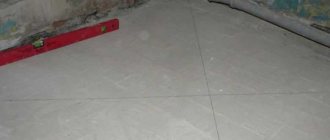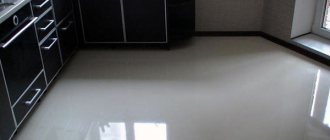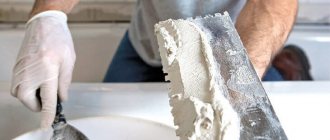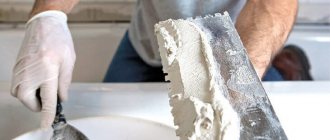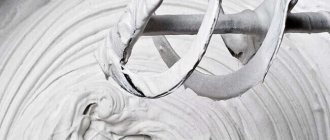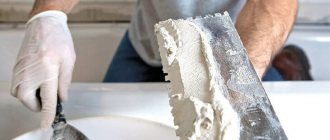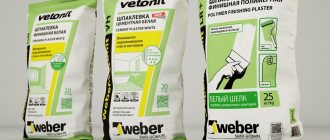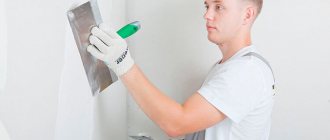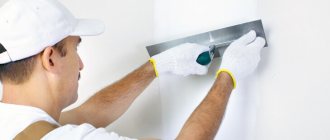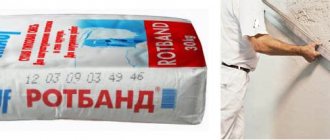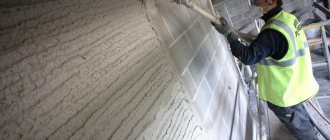To obtain a smooth surface and avoid mistakes when choosing or laying laminate flooring, other types of coatings use dry mixtures, which are called “self-leveling flooring”. Their base is more liquid compared to screed, and due to the absence of large granules, systematic spreading is ensured. The top layer has a smooth structure, so the finished coating looks great and does not require special treatment with additional means. The article presents a rating of the best self-leveling floors for 2022, an overview of popular brands that produce their products for creating durable foundations.
What types of self-leveling floors are there?
Dry mixtures are suitable for those who decide to try to level the floors in the apartment with their own hands. To understand which company is better to choose products, you need to study all the varieties and advantages of the product. The main materials that modern manufacturers use for the manufacture of self-leveling surfaces are:
Plaster compositions
Most often they are used when working with a wooden surface; the room must be dry. Their main characteristics: quick drying and good thermal conductivity. Not suitable for pouring industrial floors.
Main functionality:
- Quick hardening of the layer, the coating will be ready in 3 hours;
- The products are absolutely harmless to humans when installed with your own hands;
- No shrinkage;
- Gypsum is able to absorb moisture coming from the air, thus creating an ideal microclimate inside the apartment.
The main thing you should pay attention to is the impossibility of using gypsum composition in the kitchen or bathrooms. To protect the coating from abrasion, experts recommend applying a primer and a finishing coat.
Cement compositions
The popularity of the models is due to the plasticity of the solution due to the introduction of additional impurities into its composition. As a result, during construction the base is wear-resistant and can be additionally painted with special means. The main advantages of cement mixtures are:
- Humidity will not harm the quality of the coating in any way, so it can be used in kitchens, bathrooms or other “damp” rooms;
- High strength;
- Minimal shrinkage due to the introduction of additional components into the solution.
Despite the large number of advantages, this type of mixture has a number of disadvantages. These include:
- High material consumption;
- The solution can be poured onto a base made of combined materials;
- Long drying period and possible cracks during hardening.
Polymer compositions
Today there are many types of polymer coatings: quartz-filled, polyurethane and others. They are based on astringents. Popular models differ in the number of components. When pouring a self-leveling floor into an apartment, it is recommended to buy two-component mixtures that include a hardener and plasticizing additives.
How to make a ready-made solution? It is obtained by mixing the components in a given quantity.
The main advantages of polymer mixtures include:
- Self-leveling floors are wear-resistant;
- The composition is suitable for any type of room;
- Able to withstand sudden temperature changes;
- High aesthetic properties due to the use of dye.
However, polymer floors have some disadvantages:
- Inaccessible price for most users;
- The advice and experience of many buyers suggests that when performing work it is necessary to strictly adhere to the given proportions;
- Filling must be continuous.
Coating features
When choosing the best self-leveling floor, you should know that it is based on a self-leveling mixture. It has the ability to spread quite quickly, covering the entire surface due to the gravity of its own weight. Of course, in order to achieve a high-quality result, it is worth using auxiliary tools. The result will be a smooth and even coating.
This option can be used as finishing work in preparation for laying a decorative base. It is possible that the best self-leveling self-leveling floor will become an independent surface.
This composition has a number of advantages. For example, take at least the fact that it is able to remove defects, but we are talking about small problems in the surface. The drying time will be minimal, and therefore you will be able to move around after treating the surface within 2 hours. If you decide to continue working, it is better to wait at least 12 hours. The best option is up to 20 hours.
The base can withstand light loads. It has excellent wear resistance characteristics. There is no shrinkage, which makes the work easier, and it does not require difficulty in calculating the amount of mixture used.
The best self-leveling floors have a beautiful appearance. They settle in fairly quickly. Professionals say that if you manage the time correctly, along with creating the facing coating, you can complete the surface treatment in 2 days. For example, the best cement self-leveling floor is poured in the second half of the day, and then it is left overnight. In the morning you can lay laminate flooring or lay parquet.
Please note that you should not think that even a beginner with no skills can work with self-leveling floors. Every mistake that is associated with a lack of knowledge about technology will lead to the surface becoming covered with a number of defects. The layer will be difficult to dismantle.
In order to decide - self-leveling floor or screed, which is better, you can consult with a specialist. Our article will also be useful. Do not forget that when choosing a self-leveling floor, it is important to take into account that all compositions have similar disadvantages.
Negative qualities are associated with the fact that the mixture is capable of removing small cracks, but keep in mind that the base of the floor being poured should be of small thickness. If the defects are large, then it will not be possible to eliminate them.
Plus, all work on filling the floor must be done in accordance with clear technology, eliminating delays. The solution tends to dry out quickly, and therefore defects cannot be removed.
As for the price, self-leveling floors are expensive. For this reason, it is not worth choosing them in order to eliminate significant floor distortions. This solution will cost a really big pretty penny.
Remember that no matter how good the filling composition is, it does not tolerate, if the technology is violated, the master performs the work negligently. Under such conditions, the surface will quickly become unusable.
Today, compositions with a self-leveling effect make it possible to carry out work in a short time, obtaining a coating that will serve as an ideal basis for finishing work.
The best manufacturers producing self-leveling floors
The modern market is replete with a variety of coatings from different manufacturers that are used to level or decorate the surface. But not every branded product has the appropriate quality. In order not to make a mistake and purchase the best mixture, you need to give preference to companies specializing in the production of dry construction mixtures. These include:
- Ceresit/Moment. The brand produces products that are used for initial processing. It is based on gypsum, so the thickness of the applied layers will be small, from 3 to 75 mm. The brand is focused on producing thin-layer products for final finishing. Solutions are not recommended for use as a topcoat. They have a short hardening time, and are most often chosen when it is necessary to complete repairs in the shortest possible time. The manufacturer produces different types of products for repair work in residential and industrial premises.
- Knauf. The company produces products based on sand and gypsum and is considered the best in its business. It is aimed at products intended for rooms with high humidity levels. Dry mixtures can be independently combined with a finishing layer from any manufacturer. Those people who cannot decide on the choice of self-leveling floor should take a closer look at the Knauf company.
- Ivsil. The range of products is quite large. From screeds to high-density mixtures with a function that provides a perfectly even coating. The most popular are the quick-setting compounds “Express”, as well as solutions from the “Thermolight” line, which provide good sound and heat insulation.
- Bolars and Volma. These two companies produce inexpensive dry mixes. The first specializes in coatings with good sound and heat insulation. The second produces universal products aimed at rooms with high humidity levels.
- Prospectors. The company also produces budget products and is engaged in the production of self-leveling floors used in facade insulation systems for buildings and structures.
- A relatively inexpensive solution is mixtures. Despite the fact that the products do not have special properties, their price and material consumption are several times cheaper than their foreign counterparts. It can become indispensable during renovations.
Mistake 1: Choosing the wrong material
The survey showed that 16% of respondents inattentively read the description of the characteristics of levelers, as a result of which they buy completely different floor mixtures that are needed for this particular repair. There are no universal materials suitable for all types of premises, which is why each manufacturer has a whole line of floor levelers.
Floor mixtures differ in the method of application, layer thickness, quality of the resulting surface, curing and drying time, and interaction with the topcoat.
In this case, it is better to choose cement-based mixtures rather than gypsum-based ones, since they are more versatile. Parquet layers also adhere to the same position, since laying parquet with glue on a gypsum base is strictly not recommended.
So, before buying a self-leveling mixture, you need to decide what will be on this floor - parquet, parquet boards, tiles or laminate.
Rating of the best universal mixtures
They are used at different stages of construction work. The composition will evenly fill all cracks and roughness, instantly distribute, dry, forming an even and smooth surface.
Weber Vetonit Fast Level
The product, according to buyers, is considered one of the best for large rooms, where it is not at all easy to achieve a level base. The composition of the working solution contains small granules of about 0.6 mm. This innovative solution allowed for rapid dissolution and self-leveling during movement. Construction material used as a base layer for any type of floor covering. Packaging 20 kg in one package.
Weber Vetonit Fast Level
Pros:
- The working composition instantly hardens, and after 4 hours you can walk freely on the coating;
- The finishing layer is applied after one day;
- The finishing material is easy to use;
- The mixture can be laid on concrete, gypsum, cement bases;
- Consumption of the finished composition is 16 kg per square meter;
- Filled in apartments with high humidity;
- Wide range of layer thicknesses.
Minuses:
- The price of one package is 355 rubles;
- Short shelf life, only 6 months;
- The solution hardens within 30 minutes.
Knauf Tribon
The manufacturer claims that the dry mixture is only suitable for wood and concrete floors. It consists of gypsum, cement and is used in different conditions, that is, in completely dry apartments or with high humidity. Also combined with additional products. Self-leveling self-leveling floors harden within 60 minutes, so large areas can be covered. The technological passage is completed after 6 hours. Compatible with any type of base.
Knauf Tribon
The main advantages include:
- Highly resistant to cracks;
- Sets quickly;
- Spreads well;
- The product is universal, since the screed and leveler are presented in one package;
- Helps improve the microclimate in the apartment;
- Layer thickness is from 10 to 60 mm (in some cases more);
- One package contains 30 kg.
The disadvantages include:
- High price 300 rubles;
- When creating a screed on a wooden surface, it is necessary to create a separating or insulating layer. The base must have a high level of strength to protect against any biological damage.
Universal mixture Osnovit Skorline FK45 R
The solution is used at all stages of surface leveling.
Universal mixture Osnovit Skorline FK45 R
Pros:
- The layer thickness reaches 100 mm;
- The mixture is used in offices and residential premises;
- Compatible with different types of bases;
- In one package 20 kg;
- Affordable price - 275 rubles.
Minuses:
- The solution becomes unsuitable for further use after 40 minutes;
- For use only in dry or damp areas.
Universal composition Ceresit CN 175
It is suitable for concrete floors, cement-sand, gypsum, and other types of rough coverings and is intended for laying linoleum, ceramic tiles, carpet, laminate in residential and administrative premises.
Universal composition Ceresit CN 175
Pros:
- Can be poured onto fragile surfaces;
- Crack-resistant;
- Used on heated screeds;
- Due to the absence of harmful components, the mixture is absolutely safe for humans;
- Can be applied manually or mechanically;
- You can walk on the finished surface after 6 hours.
Minuses:
- High price - 350 rubles;
- Suitable for indoor work only;
- The maximum pot life of the solution is 30 minutes.
How to choose a floor depending on the room, base or final finish
All brands of flooring are different. To choose the most suitable one, it is better to consider in advance exactly where the floor will be poured:
- In residential apartments and houses. It is better to choose mineral poured coatings; epoxy or polyurethane are also suitable (they can be used without finishing).
- In the kitchen, mineral mixtures are suitable under laminate, tile or linoleum.
- In the bathroom and toilet where the tiles will lie, a cement-based floor or polymer compositions are required. In baths it is also worth using cement, but without gypsum impurities.
- When sealing a balcony, porch and any external areas, it is important to choose frost-resistant mixtures. Polymer grades are suitable, but gypsum should not be used at all.
- It is better to pour a polyurethane floor in the garage. You can make a cement screed and cover it with a thin layer of polyurethane.
It is also important what basis the self-leveling floor will be on:
- Concrete (floor slab). Any composition can be poured onto it.
- Waterproofing (bitumen) or old tiles. You will first need to fill it with a floating cement-sand screed about 4 cm thick, then apply a thin layer of the final fill onto it. You can use a self-leveling floor for screeding.
- Wood or insulation. First the cement screed, then the final finishing.
Exterior decoration also matters:
- You can pour any mineral mixture under the tiles.
- Any floors are suitable for linoleum, parquet, carpet and other coverings.
Rating of high-quality finishing self-leveling floors
They are the best polymer mixtures, forming a smooth, defect-free coating when dried. First, a universal solution is applied, and a finishing self-leveling floor is applied on top of it.
Weber Vetonit Finish Level
This super-thin, self-leveling floor allows you to have a level base within one day of completion. It has positive user reviews and can be used for laying tiles, carpet, parquet, and laminate. Despite the fact that one package costs 597 rubles, it can be applied in a layer of 1 to 5 mm on an inexpensive screed, which will significantly save your budget.
Weber Vetonit Finish Level
Pros:
- Economical consumption;
- Technological passage is possible within three hours;
- Internal heating of the underfloor heating system does not affect the coating in any way;
- The mixture is waterproof;
- One bag requires only 5 liters of water;
- The flooring can be laid the next day.
Minuses:
- High cost - 597 rubles.
Volma Nivelir express finishing mixture
The self-leveling floor consists of a gypsum base, quartz sand, a polymer modifying additive and binding components. Thanks to this combination, the solution has high plasticity, which provides an even and smooth base. The layer thickness ranges from 7 to 100 mm, so it is possible to level surfaces with pronounced defects. One package contains 20 kg.
Volma Nivelir express finishing mixture
Pros:
- There is no need to sand the finished layers;
- The flooring is suitable for different types of substrate;
- Hardening time 7 hours;
- Average price 240 rubles;
- Foot traffic after 6 hours.
Minuses:
- Rapid hardening of the mixture. If the floors are not filled within 60 minutes, the solution is not suitable for further use.
Weber 3000 finishing mixture
It is a finishing self-leveling floor. The thickness of each individual layer ranges from 0 to 5 mm. Experts recommend using it as a basis for laying thin lining coatings. Thanks to low consumption, it is economical to use.
Weber 3000 finishing mixture
Pros:
- Quick-drying, you can walk on the coating after 4 hours;
- Has high strength characteristics;
- Thanks to good spreading, the mixture is convenient to work with.
Minuses:
- An unaffordable price for most buyers, which is 662 rubles.
Finishing mixture Ceresit CN 68
To understand which product is better to buy, it is worth considering that these products are used only on fragile foundations. A professional composition is useful if it is necessary to level surfaces made of concrete, gypsum or cement-sand bases. Suitable for laying all types of flooring, except parquet. Not intended for use in damp and damp apartments.
Finishing mixture Ceresit CN 68
Pros:
- Easy to lay down and level;
- Can be applied mechanically;
- Technological passage is possible after 4 hours;
- The building material can be used on heated screeds;
- Does not contain harmful substances for humans.
Minuses:
- Not intended for exterior decoration, damp, wet rooms;
- High price 474 rubles.
Mistake 6: forgetting about a technology break
Every second person believed that the technological break allotted for drying the screed is not completely necessary (in some cases it takes up to several weeks), and the topcoat can be laid in just a week.
In practice, the best solution would be to adhere to the deadlines stated by the manufacturer.
Otherwise, this may lead to deformation of the wood and laminate. If you cannot wait long, then it is better to purchase a modified mixture with a rapid increase in strength at the stage of purchasing materials.
Pros and cons of self-leveling floors
Why you should choose self-leveling flooring:
- Appearance. The finished coating should be smooth and shiny. If desired, it can be painted in any color. In addition, matte or, on the contrary, glossy compositions with the addition of decorative elements are now sold, allowing you to create 3D floors.
- Easy care. Flooring is often used in institutions with high sanitary and hygienic standards, but since the finished surface does not have seams, it is much easier to care for. In addition, the characteristics of polymer floors do not contribute to the appearance of fungi, harmful bacteria and other microorganisms.
- Durability. Properly executed pouring technology will ensure a long service life of the self-leveling floor, about 40 years.
- Fire safety. Polymer components are highly flammable and do not emit harmful substances when burned. Different types of dry mixtures can be resistant to frost, sunlight, moisture and aggressive or chemical environments.
- High level of adhesion. Possibility of obtaining adhesion to different substrates.
- Easy installation. By following the rules specified by the manufacturer, anyone without any special skills can install a self-leveling floor at home.
- The packaging contains step-by-step instructions for filling the floor for those who carry out the repairs themselves.
Minuses:
- A difficult initial stage, where it is necessary to prepare the base and choose a pouring method.
Filling principle
Each mixture has its own characteristics, which, although slightly, affect the filling technology. This is primarily the pot life, setting time and mobility grade.
The viability of the solution is indicated when it is in a container (container).
Manufacturers quite often do not indicate the mobility grade on the packaging, believing that the mobility of a properly prepared solution is sufficient to fill the specified area in one layer before the pot life expires.
The main stages from different manufacturers are not fundamentally different, and look like this:
- Preparing the base. A standard procedure for pouring a screed, which includes cleaning the surface from dirt and dust, treating with a primer, repairing cracks (or laying a separating layer for weak and old foundations), laying a damper tape around the perimeter along the enclosing surfaces and columns. For pouring thick layers, it is also recommended to install beacons, and for large areas, laying expansion joints.
- Preparation of the solution. For manual and machine application, there are recommendations for the volume of the mixture for one serving, taking into account the pot life time. But the principle is the same - the mixture is poured into clean water in a certain proportion and stirred until a homogeneous mass is formed. Let it sit for a while and stir again.
- Filling. The solution is poured onto the surface, spreading evenly with a special mop. Beacons are removed (if any). Finally level and remove air bubbles with a needle roller.
conclusions
How to choose a self-leveling floor is not a difficult question. The main thing is to determine the main selection criteria: where the coating will be used, how much it costs, etc. The more requirements, the higher the cost of the self-leveling coating and the more reputable the manufacturer.
When choosing, consider the shortcomings of the product. So for most of them, careful preparation of the base is required. The coating does not have a special design and is not natural, which can be seen simply by looking at the photo. Despite this, the self-leveling floor can be replaced if desired by simply laying parquet or other covering on top. In addition, dry mixtures are often used instead of floor screed.
Before starting work, you should carefully read the product description and instructions and try to follow them in the future. Dry mixes love precision. Epoxy self-leveling flooring has more design solutions. Today, self-leveling bases allow you to complete work in the shortest possible time, while obtaining an ideal coating that will become a reliable base.
It is worth exploring new products from domestic manufacturers. The quality of the finished product is no worse than foreign brands.
Error 3: unprimed surface
26% of respondents did not even think about using a primer.
The result in this case, as a rule, is the same - a fragile, peeling floor with cracks, which they then try to hide behind the finishing coating.
The fact is that an unprimed base quickly absorbs moisture, violating the required water-cement proportion.
Particular attention should be paid to the loose base - treat it with a primer at least twice.
Surface preparation
If the floor has not yet been disassembled, it must be dismantled and completely cleared of construction debris. Use the solution to remove greasy stains - if you ignore this step, the polymer coating will not adhere well.
After cleaning, you need to carefully inspect the floor for changes. If there are any, they will need to be sealed. When this stage is completed, the floor must be cleaned again, now using a powerful vacuum cleaner.
After preparing the floor, its surface must be thoroughly primed. Primer treatment will significantly increase the adhesion of the floor to the future polymer floor, as well as prevent peeling of the finished coating.
Error 7: leaving drafts and not protecting the screed from direct sunlight
Once the floor is finished pouring, you can relax and wait quietly. This position was voiced by 36% of buyers.
But this is a mistaken opinion. Even before starting work, you must make sure that there are no drafts in the room, that the windows are closed, and that direct sunlight does not fall on the floor surface. Otherwise, this will lead to premature drying of the mixture and the appearance of shrinkage cracks, as well as peeling of the screed from the base.
Incorrect use of heat guns leads to the same result - they should be aimed at the ceiling, and not at the floor surface. It is very important not to overheat the room. A temperature of +25°C is sufficient.
Right on the sore spot, I recently did some repairs, well, not me, but the repairmen, if you can call them that. In general, the floor, although it is laid with laminate, is just like after a “bombing”, or like our roads, everything creaks and sags.
And this is an interesting thing with rubber crumbs, and it can be used on playgrounds. We need to take it into account.
I know people who have laid laminate and even linoleum on warm water floors. It's clear what this could lead to. And I know people who laid laminate flooring in the gym, and the first dumbbell that fell made a hole in the floor.
The best floor screed
In a new room or one requiring major renovation, as a rule, you have to decide the issue of arranging floors and choosing a screed.
A screed is an intermediate layer between the base of the floor and the floor covering; it compensates for unevenness, provides heat and sound insulation, and masks utility lines.
The screed is made from various building mixtures, carefully leveling and smoothing them. It is important that there are no voids or cracks in the screed; the service life of the floor depends on this.
Methyl methacrylate compounds
These mixtures are used for industrial premises. They are highly resistant to wear and are not afraid of chemical attack and moisture. Heavy vehicles and other equipment can drive on the surface.
Quick-drying mixtures are poured by specialists mechanically. Filling time is limited, so it is difficult to get a smooth surface manually. When hardened, the composition emits a pungent odor, so it is better not to use it for residential premises.
Advantages:
- high strength;
- hardness;
- resistance to any loads and chemical influences.
The disadvantage is rapid drying, requiring mechanical filling, as well as an unpleasant odor.
